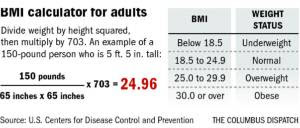Body-mass index fails to identify some as obese, mainly women

 Many Americans, particularly women, are actually obese though they think their weight is healthy because of weaknesses in the body-mass index formula.
Many Americans, particularly women, are actually obese though they think their weight is healthy because of weaknesses in the body-mass index formula.
A study comparing people’s BMIs to a blood test and body scan found that the height-to-weight ratio formula was wrong in half of women and 1 in 4 men.
“It’s commonly acknowledged that the BMI can produce inaccurate results for athletes and others with a lot of muscle mass,” Misti Crane reports for The Columbus Dispatch . “But this research illuminates a problem on the other end of the scale: people who think they’re fine but are carrying a lot of fat and little muscle.”
“Particularly women, as they age, their muscles become inserted with fat, even though they stay thin and beautiful in a dress,” said Dr. Eric Braverman, a New York physician who co-wrote the study.
Braverman and co-author New York State Health Commissioner Nirav R. Shah propose that the BMI cutoff for determining obesity should be 24 for women and 28 for men. Now, it’s 30 for both sexes. “They also say that doctors should consider blood tests to measure leptin, a hormone that goes up with increased body fat, and DXA scans. The scans are commonly used to assess bone density but can be used to analyze body fat,” Crane reports.
Though experts know the BMI calculation is not perfect, there is one major advantage: It’s free. “You have to understand that BMI is an estimate of fatness, it’s not a measure of fatness. But there are very few screening-tool estimates we have that are as simple to use,” said Dr. Patricia Choban, medical director of the bariatric-surgery problem at Mount Carmel West Hospital. (Read more)